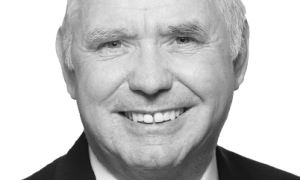Medicare spent $1 trillion last year, and it is growing rapidly. It will spend nearly $2 trillion ten years from now. It is a major driver of the rising federal debt that, as the Congressional Budget Office has warned, threatens us with economic catastrophe.
This is a long-standing problem. Former CBO director Douglas Holtz-Eakin points out that the program has experienced funding shortfalls for all but two years of its existence and that by 2019 it accounted for more than a third of all federal debt.
According to the Kaiser Family Foundation, 73 percent of Americans are aware that sustaining the popular program will require changes. And despite reluctance from both parties to face the issue, House Speaker Mike Johnson is proposing a bipartisan debt commission, which inevitably will have to reckon with Medicare and other federal entitlements.
Fortunately, there are good ideas on how to preserve Medicare—that is, to provide the highest-quality care while addressing these fiscal challenges. Many of them appear in Modernizing Medicare: Harnessing the Power of Consumer Choice and Market Competition, a recently published book from Johns Hopkins University Press, which I co-edited. It brings together top experts in the field, including Holtz-Eakin, and this article draws from it throughout.
>>> Beware of Bureaucratic Threats to Medicare Advantage
While differing on technical solutions, these experts are united on the need to strengthen the program’s consumer protections. They propose to preserve Medicare through market-based reforms. Patients would have a broad choice of plans and providers, and price competition among both would be intense.
University of Pennsylvania economist Mark Pauly observes that to be politically viable, reform must build on what Medicare beneficiaries know and like. That is why the Medicare Advantage (MA) program—a system of competing private health plans with rapidly rising enrollment covering more than half of all Medicare beneficiaries—is the strongest platform for positive change.
Medicare Advantage offers affordable comprehensive coverage—including, crucially, protection against catastrophically large medical expenses—and has a record of superior-quality care. At the same time, yearly health-plan bids to deliver traditional Medicare benefits routinely come in at a cost less than that of traditional Medicare itself. Former Medicare trustee Charles Blahous counsels making more use of the features of MA that have made this success possible: financial incentives, which could be made “more robust and transparent,” for participants and insurance providers; and flexibility, which could be expanded, for competing health insurers to deliver high-quality medical care at the lowest feasible cost.
The experts acknowledge, however, that Medicare Advantage has certain weaknesses. Flawed payment and insurance-risk-adjustment systems are driving MA costs higher than they should be. They need to be fixed so that the program can provide a stronger foundation for long-term improvements to Medicare.
Economist John Goodman, the father of the tax-free health savings accounts enjoyed by millions of people, argues that we should also let seniors have accounts from which they could bypass the Medicare bureaucracy and its regulations to pay directly for medical services. Recognizing that the health needs of seniors, especially those with chronic illnesses, are complex and varied, Goodman stresses the importance of their personal empowerment through such accounts. This would not only enable these seniors to see direct-primary-care physicians regardless of insurance networks but also facilitate their easy access to a broader range of medical professionals and specialists.
A big political hurdle has already been overcome. Thanks to MA and the Medicare prescription-drug program, most Medicare patients receive much of their care in a defined-contribution system of financing. The government, that is, makes an annual per capita contribution to a patient’s chosen health plan. The idea that people can shop for care with the help of that contribution can no longer be so easily characterized as a “risky scheme.”
Several steps should be taken to improve the payment system for MA plans. The government contribution to MA plans is based in part on the results of a county-by-county bidding process—a relic of the traditional Medicare program. The bidding should instead be based on regions, which would both allow for greater competition and better reflect how more Americans get health care through regional health systems. MA plans should also make bids that provide the benefits not only of traditional Medicare but of prescription-drug coverage, too. As with today’s MA plans, seniors could choose a plan with a premium higher than the government contribution if they were willing to make up the difference themselves. Unlike today’s plans, they would keep all the savings in the form of cash if they chose a plan that cost less than the government contribution.
Government payments to Medicare Advantage plans aren’t based on just the cost of traditional Medicare’s benefits and market bids. They also have to be adjusted for enrollees’ demographic characteristics and health risks to maintain insurance-market stability. But the way Medicare does this should change. Today, MA plans make a prospective assessment of the health risks of their enrollees, which inevitably involves guesswork and invites gaming. The risk-adjustment portion of the payments should instead be made retrospectively, based on actual costs incurred.
While MA has been gaining enrollees, many seniors are more than satisfied with traditional fee-for-service (FFS) Medicare, and they should not be compelled to leave. But traditional Medicare badly needs reform, too, argues Joseph R. Antos, a senior fellow at the American Enterprise Institute and a former assistant CBO director. It should be streamlined by combining Parts A (hospitalization), B (physicians’ services), and D (prescription drugs) into a single, comprehensive, and integrated FFS health plan, with a single deductible, simplified cost-sharing, and an annual cap on out-of-pocket costs.
>>> House Speaker Johnson’s Proposed Debt Commission Can Secure a Great Medicare Future
Transforming traditional Medicare into a comprehensive and updated health plan would have several advantages. It would not only reduce seniors’ reliance on additional premium payments for supplemental private insurance, but it would also guarantee them protection from the financial devastation of catastrophic illness. This transformation, combined with an improved system of defined-contribution financing, would also enable traditional FFS Medicare to compete directly with Medicare Advantage plans on a level playing field in every region of the country.
Expanding and improving defined-contribution financing beyond MA and Medicare Part D, and allowing all seniors to enroll in a competitive market of comprehensive coverage with catastrophic protection, would facilitate seniors’ access to a higher quality of medical care. Intensified health-plan and provider competition, in a fully transparent environment of price and provider performance in delivering quality care, would drive innovation in benefit design and improve health-care delivery.
Obviously, with the rapid growth of the 65-and-older population, America will spend ever larger sums on seniors’ health care. Facing the nation’s debt crisis, however, the president and the next Congress will be compelled to address Medicare’s multiple challenges. They will need to make crucial policy choices to slow Medicare spending and secure the best value for taxpayers’ dollars. “Saving” money by tightening Medicare’s existing administrative payments and price controls is not the answer. Central planning and price caps, enacted as part of the Affordable Care Act of 2010, already threaten seniors’ access to good care. More bureaucracy is no prescription for better care.
The superior route is to build on the best features of Medicare’s competitive programs, Medicare Advantage and Medicare Part D, and transform the entire program into a dynamic, competitive system. That option holds promise. Basing his calculations on the CBO’s baseline, Holtz-Eakin estimates that a fully competitive Medicare program would save $2.2 trillion over ten years, including $333 billion in savings for beneficiaries.
Real Medicare reform will benefit seniors as well as the taxpayers financing the bulk of their care.
This piece originally appeared in the National Review




